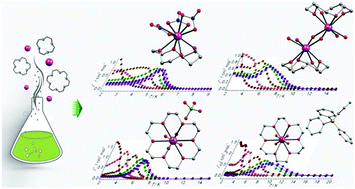Syntheses, structures and magnetic properties of a series of mono- and di-nuclear dysprosium(iii)-crown-ether complexes: effects of a weak ligand-field and flexible cyclic coordination modes†
Abstract
Crown ethers, which feature circular and variable coordination sites of oxygen atoms, may be ideal for the symmetry control of the mononuclear lanthanide single-molecule magnets (SMMs) by double-deckering the central metal ions. Herein, a series of Dy(III)-crown-ether complexes have been prepared to test this hypothesis. With a 12-crown-4 ether (12-C-4), a half-sandwich complex Dy(12-C-4)(NO3)3 (1) was obtained, while by changing the counter-anions the double-deck-like complex Dy(12-C-4)2(CH3CN)(ClO4)3 (2) could be prepared. On further adjusting the reaction conditions, a dinuclear complex Dy2(12-C-4)2(ClO4)4(OH)2(H2O)2 (3) was isolated. With the aid of a 15-crown-5 ether (15-C-5), another complex [Dy(12-C-4)(15-C-5)(CH3CN)][Dy(12-C-4)(15-C-5)]2(CH3CN)2(ClO4)9 (4) with a double-decker structure was formed. For the 18-crown-6 ether (18-C-6), two complexes [Dy(18-C-6)(NO3)2]ClO4 (5) and [Dy(18-C-6)(NO3)2]BPh4 (6) have been synthesized using different charge balancing anions. Interestingly, the cationic components in complexes 5 and 6 are isomeric. The only difference is the dihedral angles of the two chelating NO3− groups, namely 90° and 68° for 5 and 6. Systematic magnetic studies reveal that complexes 1–6 show no SMM behaviour in a zero dc field above 2 K, which is probably due to the ligand field provided by crown ethers is too weak to have much impact on the electronic structures of the central Dy(III) ions. However, when the Dy(III) ions are simultaneously coordinated by some counter-anions such as NO3− and OH−, apparent field-induced SMM behaviors can be observed in complexes 1, 3, 5 and 6. Moreover, we found that the axial coordination anions in complexes 5 and 6 have evident impact on the magnetic relaxation behaviours. For the 90° case (complex 5) the energy barrier for magnetisation reversal (ΔE) is 63 K, which is much higher than 43 K for the 68° case (complex 6).

- This article is part of the themed collection: 2015 Emerging Investigators by ICF

 Please wait while we load your content...
Please wait while we load your content...